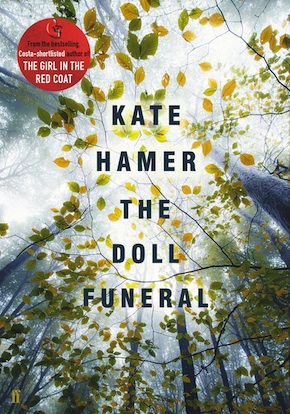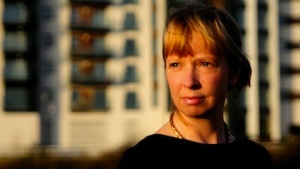Out there
by Kate Hamer
“A haunting story of love, loss, family and friendships.” Lisa Ballantyne
The Doll Funeral began as an image of a young girl running out from the back door into an unkempt garden. In my mind it’s as if there is a camera tracking behind her. The camera follows her out into the garden where she jumps off the step, runs through the overgrown grasses and begins singing in joy to the sky. Meet Ruby. It’s her thirteenth birthday and she’s just been told she was adopted as a baby.
She has her reasons, of course, that prompt such a reaction. Life with her adopted parents Mick and Barbara has been a brutal and uncompromising one. The knowledge gives her hope and she begins the quest to find her real parents. But this is a dangerous mission. Her delving into the past begins to uncover family secrets – both in her own and in other families. It will eventually lead to a finding a corpse. It will test Ruby in body and soul.
I first had the idea a few years ago to write this story of how the past interacts with the present, causing dangerous vibrations, and the possibility of escaping that past and forging a new life for oneself. However, try as I might somehow the location never seemed to fit the narrative. I tried writing it set in the South Wales valleys and also Manchester, but it never felt embedded. The more I thought about it, the more I came to the realisation that Ruby was a girl from the country, just the ‘sense’ of her was not an urban one. Then, one day on a day out in the little border town of Monmouth I saw a sign pointing over the ancient stone bridge to the Forest of Dean. “Let’s have a look,” I said to my husband. Pure serendipity, I knew as soon as I came under the forest canopy that I’d found my location. The story dropped into place and the forest breathed its own life into it.
Forests have such a place in our folk memory and in fairy tales as places of threat, retreat and mystery.”
The Forest of Dean is a fascinating place. It’s an ancient royal forest. Oaks grown there form the roof of York cathedral and the Tower of London. It has also been mined for iron and coal since Iron Age times. Coal mining has a particular tradition in the forest with so-called free miners who, if they managed to discover a seam of coal were able to mine it for profit themselves and even name it. These names are often quirky and intriguing – Pluck Penny, New Fancy, etc. Now there are twenty-first century communities nestling in the heart of the forest, but the place still holds a sense of mystery and intrigue that feels very ancient. As one of my characters says: “Who knows what was out there, getting buried year on year by another layer of leaves.”
Forests have such a place in our folk memory and in fairy tales as places of threat, retreat and mystery. If there’s one fairy tale that stands out for me as having the same threads as The Doll Funeral it would be Snow White. Like Snow White, Ruby has to fend for herself in the forest, she has beauty (albeit an unconventional kind), and observant readers will notice a mirror! I definitely felt the forest became another character in the story.
The abiding theme of The Doll Funeral is the question, “Can we escape from our past?” The past resonates through Ruby’s life in ghostly ways. She’s subject to all the lost souls in the world sticking their fingers in and meddling. Ruby feels that the answers she seeks must be in her birth parents, ‘the soil’ that she was grown in, as she puts it. But as her investigations continue the truth she uncovers is a dark one. She seems to have a knack for this. When she is led to a group of teenagers who are living alone she begins to realise that their secrets are even more disturbing than her own. What is family? I wanted to ask. Can we make our own or are we bound inextricably to the past and have to remain shaped by it? I’m not interested in writing about politics in the conventional sense, but the politics of the family fascinate me.
These ghosts are not spooky presences that jump out of cupboards at you, but troubling psychological conflicts that have not been resolved in families.”
The title will hopefully make sense if you read the book. I googled the title – as you do – very early on. What came up was a piece of music by Tchaikovsky and details about the Japanese practice of doll funerals. It’s a common understanding in Japan that dolls are imbued with memories or even possess souls of their own. It makes throwing them in the bin really difficult, even dangerous, as the spirits of the dolls may seek retribution on their former owner. Hence the ceremony of Ningyo kuyo, in which dolls are taken to temple and prayers are said over them, then a small representative sample are burnt on a funeral pyre. It’s a solemn ceremony that is taken very seriously. In my novel dolls go on representing the dead that once owned them.
Another link in the book to Japanese culture is through their horror and ghost films, in which the dead are almost as present as the living in the people that remember them. They are not merely spooky presences that jump out of cupboards at you, but troubling psychological conflicts that have not been resolved in families. This is something I really wanted to get across. As the secrets in Ruby’s family are stripped back, the fault lines of where it all started are revealed. Spirits walk the earth in the minds of those that go on living.
The Doll Funeral took me about two years to write. I’m working on my third book now and I’ve got a feeling it may be quicker – we’ll see. I seem to have come to a pattern of writing the beginning of the book then very quickly writing the last page and the last sentence, which doesn’t change despite the fact that I edit about three million times. I beginning to realise that each book is a completely different journey. Of course I’ve learnt from what I’ve done to a certain extent and taken things on board in technique and working method as I go along. But I also sense that with each new book I’m opening a door into a complete, uncharted place where I haven’t been before. Exciting and terrifying!
 Kate Hamer grew up in Pembrokeshire and completed a Creative Writing MA at Aberystwyth University and the Curtis Brown Creative novel-writing course. She won the Rhys Davies short story award in 2011 and her winning story was read on BBC Radio 4. She lives in Cardiff with her husband. The Doll Funeral is out now from Faber & Faber, along with her bestselling debut The Girl in the Red Coat.
Kate Hamer grew up in Pembrokeshire and completed a Creative Writing MA at Aberystwyth University and the Curtis Brown Creative novel-writing course. She won the Rhys Davies short story award in 2011 and her winning story was read on BBC Radio 4. She lives in Cardiff with her husband. The Doll Funeral is out now from Faber & Faber, along with her bestselling debut The Girl in the Red Coat.
Read more.
@kate_hamer
Author portrait © Mei Williams

